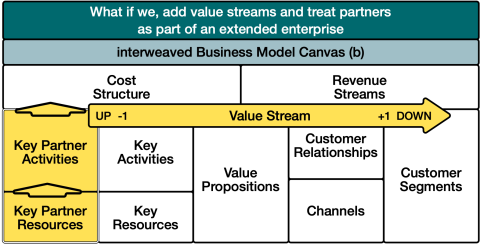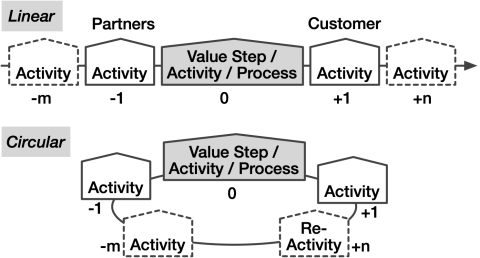Sharing and Blog
WorkEm help you improve who you are, what you do and what you aspire to.
Step b) of Reimagining The Business Model Canvas for Triple-Bottom-Line
b. What if we, add value streams and treat partners as part of an extended enterprise?
A value chain links together up-stream partner activities with a company's activities and the next customer's activities down-stream.
Research has shown that most companies are very well aware of their closest partners or suppliers (-1) and their customers (+1). However, the further away the suppliers and customers customer are, the less knowledge exists.
The baseline BMC contains three value-creating parts: partners, company, and customer (segments) arranged linearly. However, linear analysis is now challenged by the increased emphasis on sustainability and circular economies that, by necessity, introduce loops and circularity into the value chains.
In later steps, we will show how to open up BMC to circular business models based on making the value stream visible.
In Practice, the Digital Product Passport, which is soon mandatory for most products placed on the European market or put into service, is an example of how knowledge about a company's value chains becomes increasingly essential.
Secondly, we treat partners as part of a value chain where they have access to, own and use "Resources" in their "Activities".
This opens up discussions about the distribution of who should do what with resources such as materials, parts or components.
In practice, from a resource point of view, should resources be sourced from partners, be owned and controlled by the organisation, or provided by customers?
How should a resource be disassembled?
What CO2 footprint has the resource?
In practice, from a value creation point of view, should values be co-created and products be co-developed?
What services are provided by the partner or the company?
Who is making components, assembling them and making them available to the market?
How and by whom are resources disassembled?
How are resources fed back into the values stream through Re-activities (refurbishment, remake, repair, recycle, etcetera)?
Dematerialisation and decoupling are two concerns for an eco-friendly world that can now be discussed within the iBMC. Dematerialisation aims for continued growth with less material consumption in each part of the value chain. Decoupling to discuss the separation of economic growth from the consumption of raw materials.
The two patterns, value chain and value ladder provide a rich logical and systemic foundation for the iBMC and development of sustainable business models.
Note: the concepts of the value chain and value ladder are part of the Interweaving theory of Architecture, which can be interweaved into business and strategic thinking.
When you subscribe to the blog, we will send you an e-mail when there are new updates on the site so you wouldn't miss them.
By accepting you will be accessing a service provided by a third-party external to http://workem.com/


Comments